Abstract
We describe a successful program of poliomyelitis control using a combination of killed and live polio vaccines over a 10-year period in two developing areas, the West Bank and Gaza, adjacent to a relatively developed country, Israel. During the 1970s, immunization using live trivalent oral polio vaccine (OPV) in these areas covered more than 90 percent of the infant population. Nevertheless, the incidence of paralytic polio continued to be high, with many cases occurring in fully or partially immunized persons. It was thought that this could be due to interference with OPV take by other enteroviruses present in the environment due to poor sanitary conditions in these areas. A new policy combining five doses of OPV with two doses of inactivated polio vaccine (IPV) was adopted and implemented in 1978. In the 10 years since then, immunization coverage of infants increased to an estimated 95 percent and paralytic poliomyelitis has been controlled, despite exposure to wild poliovirus from neighboring countries including an outbreak in Israel in 1988. This experience suggests that wide coverage using the combination of IPV and OPV is an effective vaccination policy that may make eradication of polio possible even in developing areas.
Full text
PDF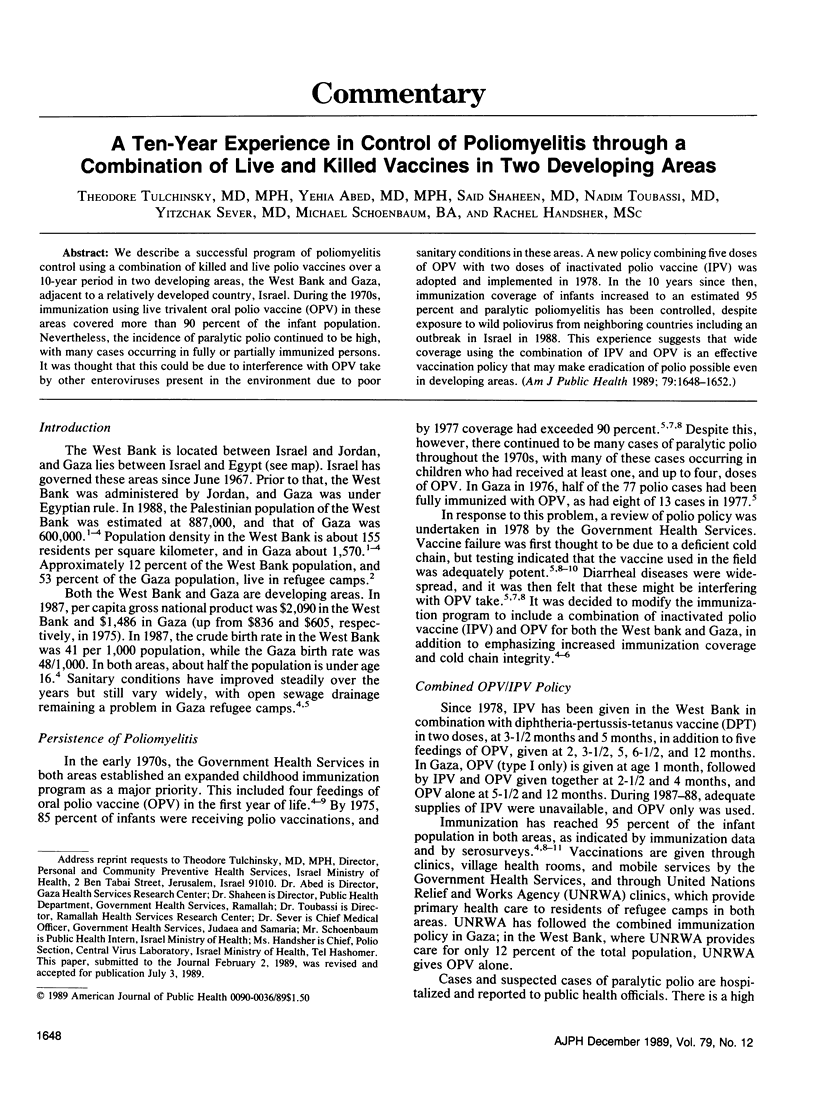
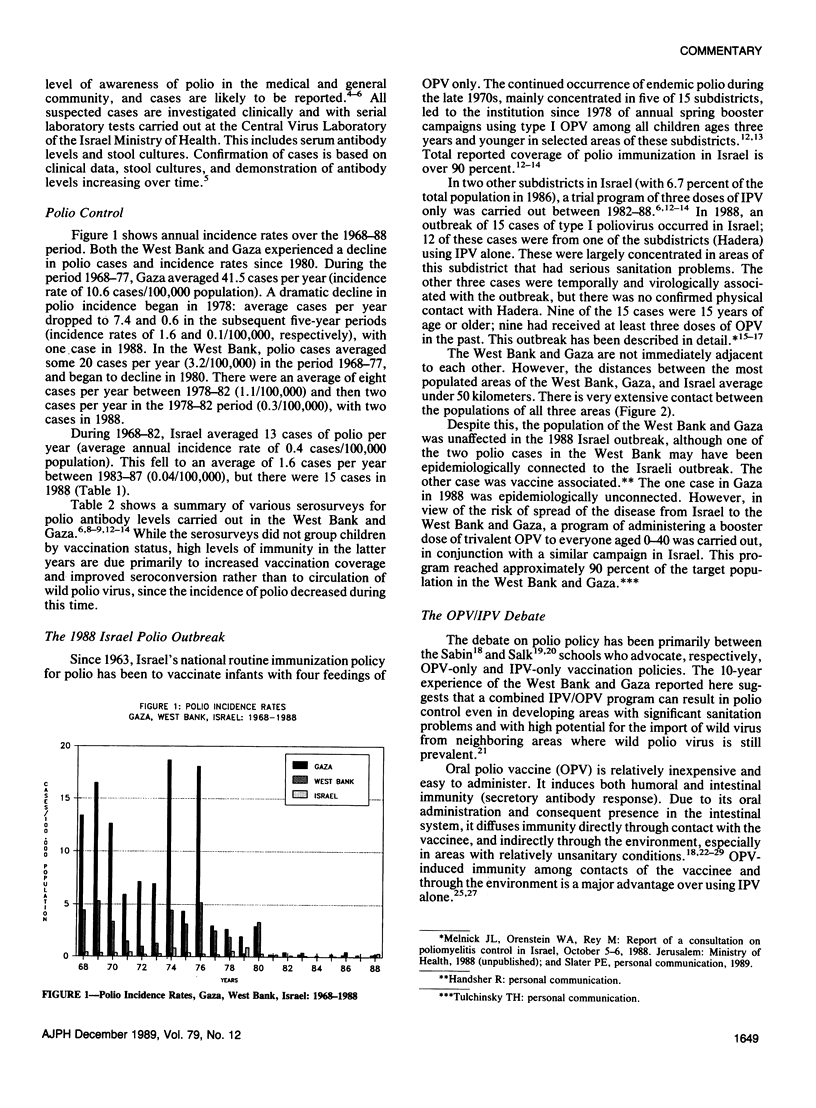
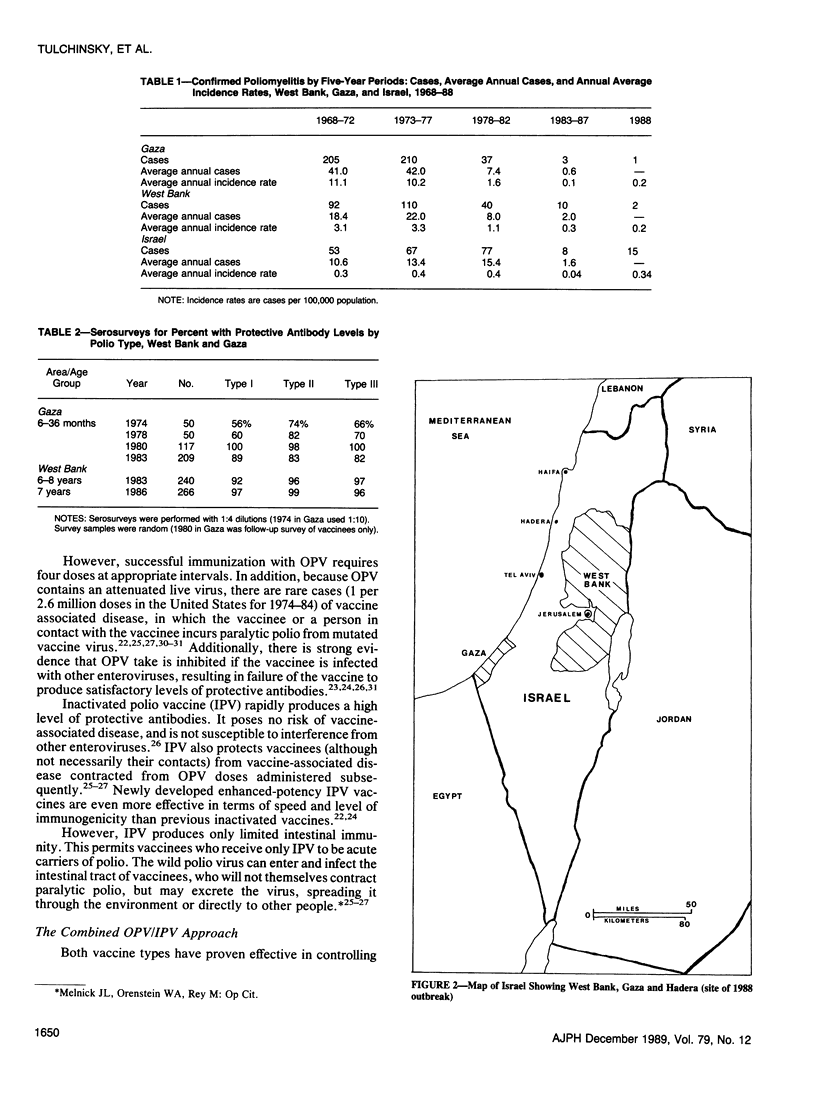
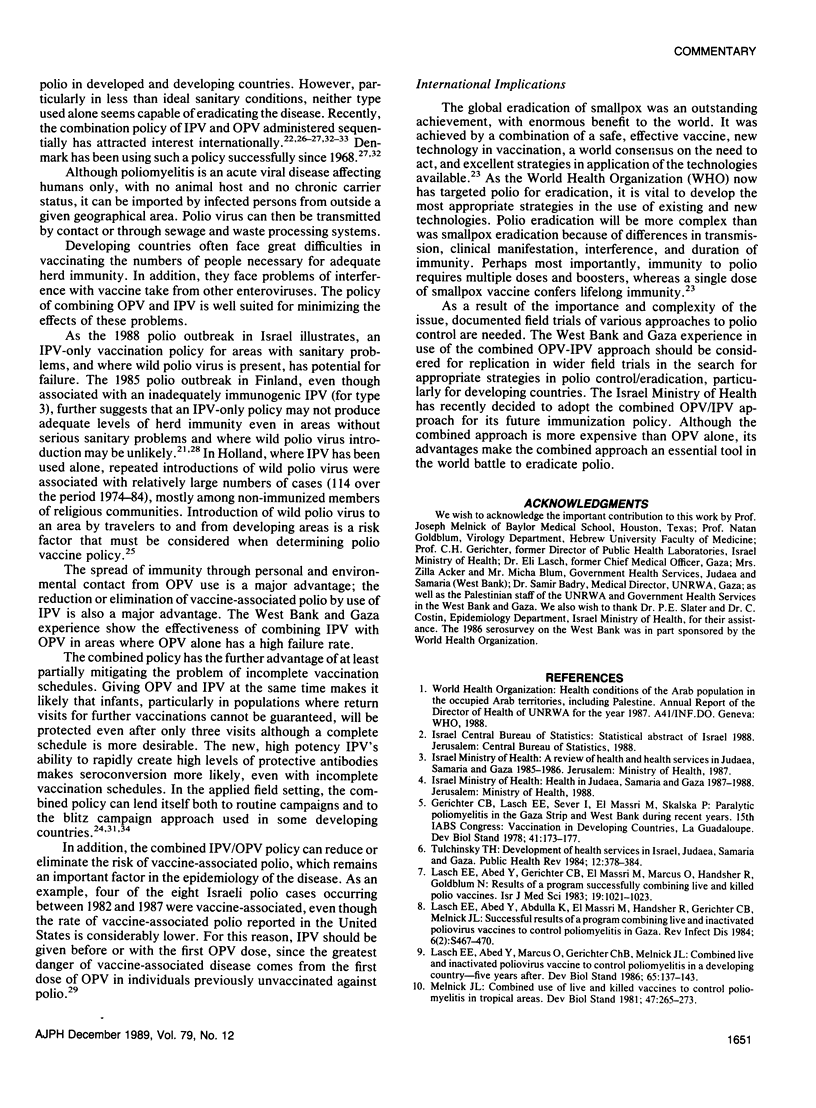
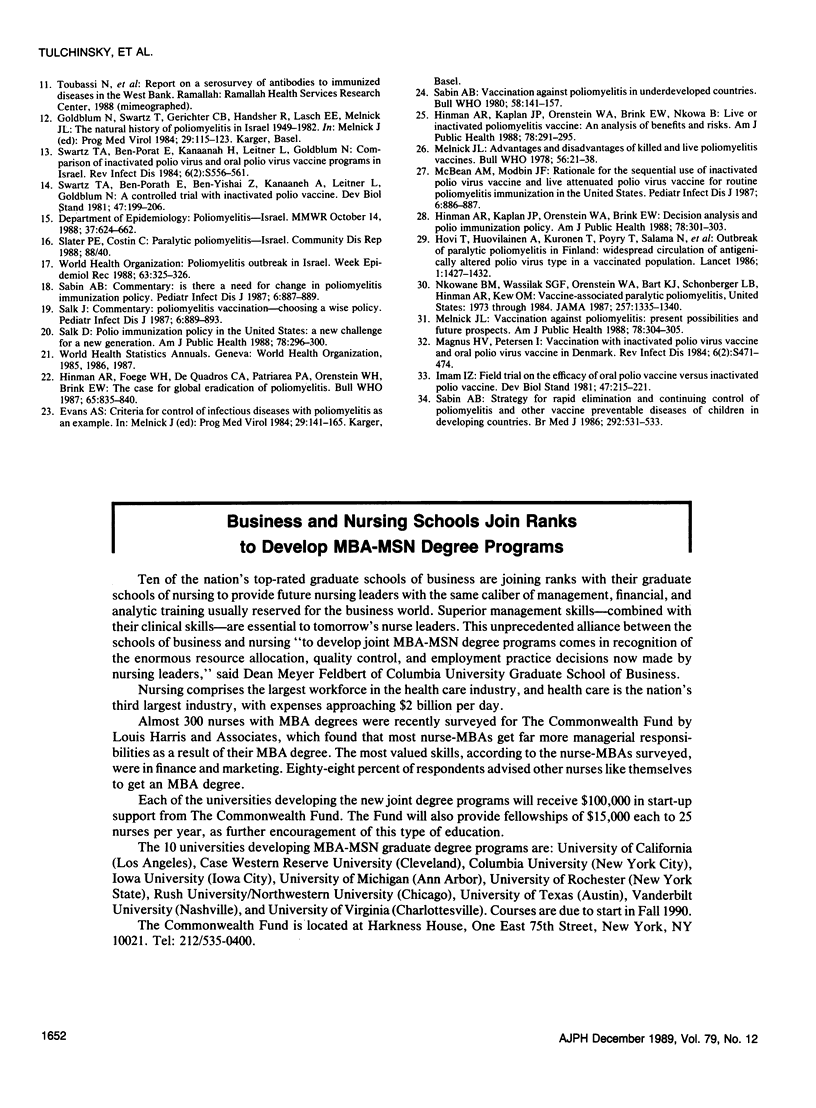
Selected References
These references are in PubMed. This may not be the complete list of references from this article.
- Evans A. S. Criteria for control of infectious diseases with poliomyelitis as an example. Prog Med Virol. 1984;29:141–165. [PubMed] [Google Scholar]
- Gerichter C. B., Lasch E. E., Sever I., el-Massri M., Skalska P. Paralytic poliomyelitis in the Gaza Strip and West Bank during recent years. Dev Biol Stand. 1978;41:173–177. [PubMed] [Google Scholar]
- Goldblum N., Swartz T., Gerichter C. B., Handsher R., Lasch E. E., Melnick J. L. The natural history of poliomyelitis in Israel, 1949-1982. Prog Med Virol. 1984;29:115–123. [PubMed] [Google Scholar]
- Hinman A. R., Foege W. H., de Quadros C. A., Patriarca P. A., Orenstein W. A., Brink E. W. The case for global eradication of poliomyelitis. Bull World Health Organ. 1987;65(6):835–840. [PMC free article] [PubMed] [Google Scholar]
- Hinman A. R., Koplan J. P., Orenstein W. A., Brink E. W. Decision analysis and polio immunization policy. Am J Public Health. 1988 Mar;78(3):301–303. doi: 10.2105/ajph.78.3.301. [DOI] [PMC free article] [PubMed] [Google Scholar]
- Hinman A. R., Koplan J. P., Orenstein W. A., Brink E. W., Nkowane B. M. Live or inactivated poliomyelitis vaccine: an analysis of benefits and risks. Am J Public Health. 1988 Mar;78(3):291–295. doi: 10.2105/ajph.78.3.291. [DOI] [PMC free article] [PubMed] [Google Scholar]
- Hovi T., Cantell K., Huovilainen A., Kinnunen E., Kuronen T., Lapinleimu K., Pöyry T., Roivainen M., Salama N., Stenvik M. Outbreak of paralytic poliomyelitis in Finland: widespread circulation of antigenically altered poliovirus type 3 in a vaccinated population. Lancet. 1986 Jun 21;1(8495):1427–1432. doi: 10.1016/s0140-6736(86)91566-7. [DOI] [PubMed] [Google Scholar]
- Imam I. Z. Field trial on the efficacy of oral Sabin vaccine versus Salk polio vaccine. Dev Biol Stand. 1981;47:215–221. [PubMed] [Google Scholar]
- Lasch E. E., Abed Y., Abdulla K., El Tibbi A. G., Marcus O., El Massri M., Handscher R., Gerichter C. B., Melnick J. L. Successful results of a program combining live and inactivated poliovirus vaccines to control poliomyelitis in Gaza. Rev Infect Dis. 1984 May-Jun;6 (Suppl 2):S467–S470. doi: 10.1093/clinids/6.supplement_2.s467. [DOI] [PubMed] [Google Scholar]
- Lasch E. E., Abed Y., Gerichter C. B., Massri M. E., Marcus O., Hensher R., Goldblum N. Results of a program successfully combining live and killed polio vaccines. Isr J Med Sci. 1983 Nov;19(11):1021–1023. [PubMed] [Google Scholar]
- Lasch E. E., Abed Y., Marcus O., Gerichter C. B., Melnick J. L. Combined live and inactivated poliovirus vaccine to control poliomyelitis in a developing country--five years after. Dev Biol Stand. 1986;65:137–143. [PubMed] [Google Scholar]
- McBean A. M., Modlin J. F. Rationale for the sequential use of inactivated poliovirus vaccine and live attenuated poliovirus vaccine for routine poliomyelitis immunization in the United States. Pediatr Infect Dis J. 1987 Oct;6(10):881–887. doi: 10.1097/00006454-198710000-00001. [DOI] [PubMed] [Google Scholar]
- Melnick J. L. Advantages and disadvantages of killed and live poliomyelitis vaccines. Bull World Health Organ. 1978;56(1):21–38. [PMC free article] [PubMed] [Google Scholar]
- Melnick J. L. Combined use of live and killed vaccines to control poliomyelitis in tropical areas. Dev Biol Stand. 1981;47:265–273. [PubMed] [Google Scholar]
- Melnick J. L. Vaccination against poliomyelitis: present possibilities and future prospects. Am J Public Health. 1988 Mar;78(3):304–305. doi: 10.2105/ajph.78.3.304. [DOI] [PMC free article] [PubMed] [Google Scholar]
- Nkowane B. M., Wassilak S. G., Orenstein W. A., Bart K. J., Schonberger L. B., Hinman A. R., Kew O. M. Vaccine-associated paralytic poliomyelitis. United States: 1973 through 1984. JAMA. 1987 Mar 13;257(10):1335–1340. [PubMed] [Google Scholar]
- Sabin A. B. Is there a need for a change in poliomyelitis immunization policy? Pediatr Infect Dis J. 1987 Oct;6(10):887–889. [PubMed] [Google Scholar]
- Sabin A. B. Strategy for rapid elimination and continuing control of poliomyelitis and other vaccine preventable diseases of children in developing countries. Br Med J (Clin Res Ed) 1986 Feb 22;292(6519):531–533. doi: 10.1136/bmj.292.6519.531. [DOI] [PMC free article] [PubMed] [Google Scholar]
- Sabin A. B. Vaccination against poliomyelitis in economically underdeveloped countries. Bull World Health Organ. 1980;58(1):141–157. [PMC free article] [PubMed] [Google Scholar]
- Salk D. Polio immunization policy in the United States: a new challenge for a new generation. Am J Public Health. 1988 Mar;78(3):296–300. doi: 10.2105/ajph.78.3.296. [DOI] [PMC free article] [PubMed] [Google Scholar]
- Salk J. Poliomyelitis vaccination--choosing a wise policy. Pediatr Infect Dis J. 1987 Oct;6(10):889–893. [PubMed] [Google Scholar]
- Swartz T. A., Ben-Porath E., Ben-Yshai Z., Weissmann Z., Kanaaneh A., Leitner L., Goldblum N. A controlled trial with inactivated poliovaccine. Dev Biol Stand. 1981;47:199–206. [PubMed] [Google Scholar]
- Swartz T. A., Ben-Porath E., Kanaaneh H., Leitner L., Goldblum N. Comparison of inactivated poliovirus vaccine and oral poliovirus vaccine programs in Israel. Rev Infect Dis. 1984 May-Jun;6 (Suppl 2):S556–S561. doi: 10.1093/clinids/6.supplement_2.s556. [DOI] [PubMed] [Google Scholar]
- Tulchinsky T. H. The development of health services in Israel and in Judaea/Samaria: lessons learned. Public Health Rev. 1984;12(3-4):378–384. [PubMed] [Google Scholar]
- von Magnus H., Petersen I. Vaccination with inactivated poliovirus vaccine and oral poliovirus vaccine in Denmark. Rev Infect Dis. 1984 May-Jun;6 (Suppl 2):S471–S474. doi: 10.1093/clinids/6.supplement_2.s471. [DOI] [PubMed] [Google Scholar]


